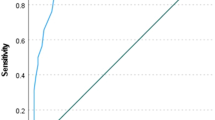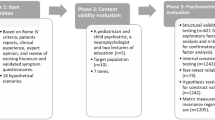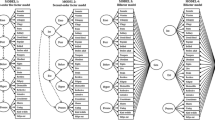Abstract
Pediatric gastrointestinal disorders are commonly experienced by youth and have been shown to be associated with increased rates of psychosocial difficulties. Aim of the current study was to extend development of the Pediatric Symptom Checklist (PSC), a brief parent-completed measure designed to assess children’s behavioral and emotional functioning, by examining its factor structure in a pediatric gastroenterology sample. Parents of 176 children ages 4–16 years visiting a pediatric gastroenterologist completed the PSC. The factor structure of the PSC was examined using principal component analysis. Parallel analysis was utilized to determine the number of factors to retain and indicated that three factors existed within the data. A principal component analysis with varimax rotation identified factors measuring internalizing, externalizing, and attention difficulties. The three factors that emerged on the PSC provide initial support for the utility of the PSC in pediatric gastroenterology clinics.
Similar content being viewed by others
References
Achenbach, T. (1991). Manual for the Child Behavior Checklist/4–18 and 1991 profile. Burlington, VT: Department of Psychiatry, University of Vermont.
Anderson, D., Spratt, E., Macias, M., Jellinek, M., Murphy, J., Pagano, M., et al. (1999). Use of the Pediatric Symptom Checklist in the pediatric neurology population. Pediatric Neurology, 20, 116–120.
Banez, G., & Cunningham, C. (2009). Pediatric gastrointestinal disorders: Recurrent abdominal pain, Inflammatory Bowel Disease, and rumination disorder/cyclic vomiting. In M. C. Roberts (Ed.), Handbook of pediatric psychology (3rd ed., pp. 462–478). New York: Guilford.
Bernal, P., & Estroff, B. (2000). Psychosocial morbidity: The economic burden in a pediatric health maintenance organization sample. Archives of Pediatrics and Adolescent Medicine, 154, 261–266.
Campo, J., Bridge, J., Ehmann, M., Altman, S., Lucas, A., Birmaher, B., et al. (2004). Recurrent abdominal pain, anxiety, and depression in primary care. Pediatrics, 113, 817–824.
Field, A. (2005). Discovering statistics using SPSS (2nd ed.). Thousand Oaks, CA: Sage Publications.
Forrest, C., Glade, G., Baker, A., Bocian, A., Kang, M., & Starfield, B. (1999). The pediatric primary-specialty care interface: How pediatricians refer children and adolescents to specialty care. Archives of Pediatrics and Adolescent Medicine, 153, 705–714.
Gardner, W., Kelleher, K., & Pajer, K. (2002). Multidimensional adaptive testing for mental health problems in primary care. Medical Care, 40, 812–823.
Gardner, W., Murphy, M., Childs, G., Kelleher, K., Pagano, M., Jellinek, M., et al. (1999). The PSC-17: A brief Pediatric Symptom Checklist with psychosocial problem subscales. A report from PROS and ASPN. Ambulatory Child Health, 5, 225.
Glorfeld, L. (1995). An improvement on Horn’s parallel analysis methodology for selecting the correct number of factors to retain. Educational and Psychological Measurement, 55, 377–393.
Hayton, J., Allen, D., & Scarpello, V. (2004). Factor retention decisions in exploratory factor analysis: A tutorial on parallel analysis. Organizational Research Methods, 7, 191–205.
Hayutin, L., Reed-Knight, B., Blount, R., Lewis, J., & McCormick, M. (2009). Increasing parent-pediatrician communication about children’s psychosocial problems. Journal of Pediatric Psychology, 34, 1155–1164.
Hommel, K. A., McGraw, K. L., Ammerman, R. T., Heubi, J. E., Hansen, M., Dunlap, E., et al. (2010). Psychosocial functioning in children and adolescents with gastrointestinal complaints and disorders. Journal of Clinical Psychology in Medical Settings, 17, 159–166.
Horn, J. (1965). A rationale and test for the number of factors in factor analysis. Psychometrika, 30, 179–185.
Jellinek, M. S., Little, M., Murphy, J. M., & Pagano, M. (1995). The Pediatric Symptom Checklist: Support for a role in a managed care environment. Archives of Pediatrics and Adolescent Medicine, 149, 740–746.
Jellinek, M. S., & Murphy, J. M. (1988). Screening for psychosocial disorders in pediatric practice. Archives of Pediatrics and Adolescent Medicine, 142, 1153–1157.
Jellinek, M. S., Murphy, J. M., & Burns, B. J. (1986). Brief psychosocial screening in outpatient pediatric practice. Journal of Pediatrics, 109, 371–378.
Jellinek, M. S., Murphy, J. M., Little, M., Pagano, M. E., Comer, D. M., & Kelleher, K. J. (1999). Use of the Pediatric Symptom Checklist to screen for psychosocial problems in pediatric primary care: A national feasibility study. Archives of Pediatrics and Adolescent Medicine, 153, 254–260.
Jellinek, M. S., Murphy, J. M., Robinson, J., Feins, A., Lamb, S., & Fenton, T. (1988). Pediatric Symptom Checklist: Screening school-age children for psychosocial dysfunction. Journal of Pediatrics, 112, 201–209.
Ledesma, R., & Valero-Mora, P. (2007). Determining the number of factors to retain in EFA: An easy-to-use computer program for carrying out parallel analysis. Practical Assessment, Research and Evaluation, 12, 1–11.
Murphy, J. M., Arnett, H. L., Bishop, S. J., Jellinek, M. S., & Reede, J. Y. (1992a). Screening for psychosocial dysfunction in pediatric practice: A naturalistic study of the Pediatric Symptom Checklist. Clinical Pediatrics, 31, 660–667.
Murphy, J. M., Jellinek, M., & Milinsky, S. (1989). The Pediatric Symptom Checklist: Validation in the real world of middle school. Journal of Pediatric Psychology, 14, 629–639.
Murphy, J. M., Reede, J., Jellinek, M. S., & Bishop, S. J. (1992b). Screening for psychosocial dysfunction in inner-city children: Further validation of the Pediatric Symptom Checklist. Journal of the American Academy of Child and Adolescent Psychiatry, 31, 1011–1105.
Navon, M., Nelson, D., Pagano, M., & Murphy, J. M. (2001). Use of the Pediatric Symptom Checklist in strategies to improve preventive behavioral health care. Psychiatric Services, 52, 800–804.
O’Connor, B. (2000). SPSS and SAS programs for determining the number of components using parallel analysis and Velicer’s MAP test. Behavior Research Methods Instruments and Computers, 32, 396–402.
Pett, M., Lackey, N., & Sullivan, J. (2003). Making sense of factor analysis: The use of factor analysis for instrument development in health care research. Thousand Oaks, CA: Sage Publications, Inc.
Simonian, S., & Tarnowski, K. (2001). Utility of the Pediatric Symptom Checklist for behavioral screening of disadvantaged children. Child Psychiatry and Human Development, 31, 269–278.
Stoppelbein, L., Greening, L., Jordan, S. S., Elkin, T. D., Moll, G., & Pullen, J. (2005). Factor analysis of the Pediatric Symptom Checklist with a chronically ill pediatric population. Journal of Developmental and Behavioral Pediatrics, 26, 349–355.
Velicer, W., Eaton, C., & Fava, J. (2000). Construct explication through factor or component analysis: A review and evaluation of alternative procedures for determining the number of factors or components. In R. D. Goffin & E. Helmes (Eds.), Problems and solutions in human assessment: Honoring Douglas N. Jackson at seventy (pp. 41–71). New York, NY: Kluwer Academic/Plenum Publishers.
Walker, W., LaGrone, R., & Atkinson, A. (1989). Psychosocial screening in pediatric practice: Identifying high-risk children. Journal of Developmental and Behavioral Pediatrics, 10, 134–138.
Whitehead, W. (1996). Psychosocial aspects of functional gastrointestinal disorders. Gastroenterology Clinics of North America, 25, 21–34.
Author information
Authors and Affiliations
Corresponding author
Rights and permissions
About this article
Cite this article
Reed-Knight, B., Hayutin, L.G., Lewis, J.D. et al. Factor Structure of the Pediatric Symptom Checklist with a Pediatric Gastroenterology Sample. J Clin Psychol Med Settings 18, 299–306 (2011). https://doi.org/10.1007/s10880-011-9242-7
Published:
Issue Date:
DOI: https://doi.org/10.1007/s10880-011-9242-7




